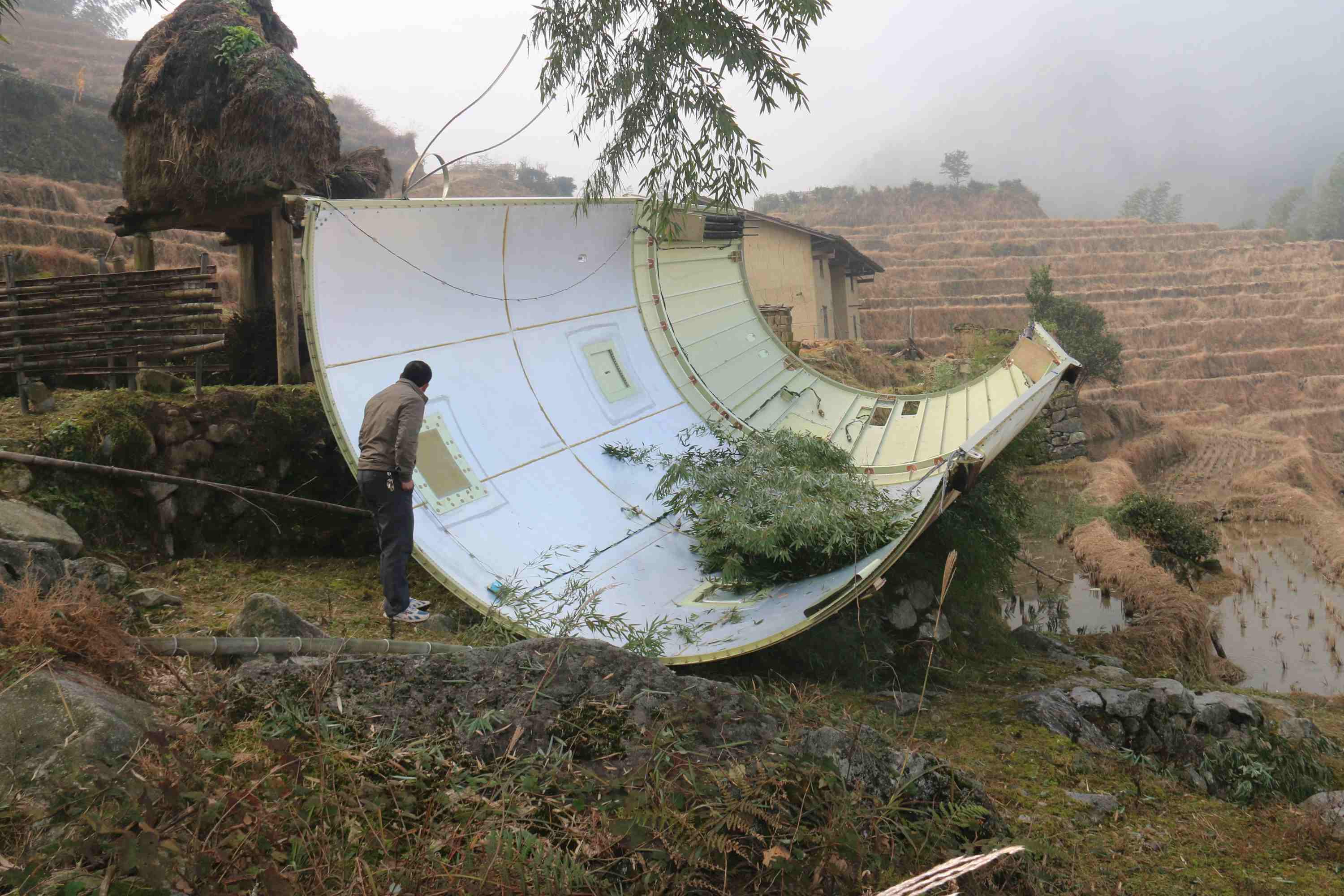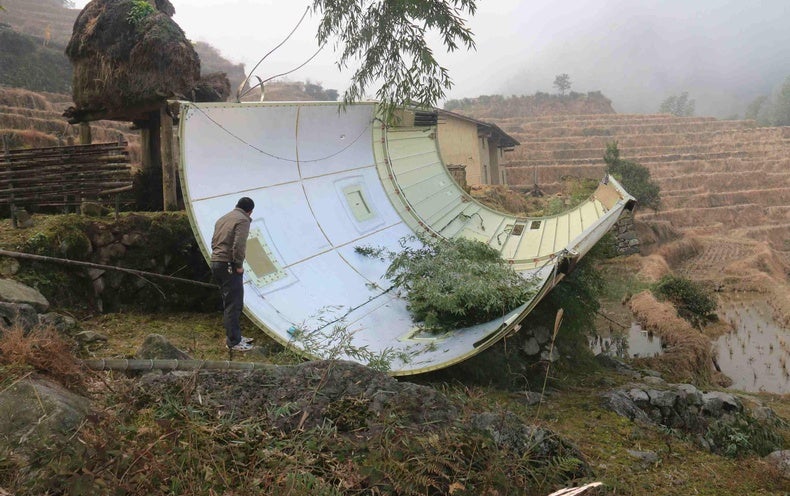
Spaceflight, despite its origins in cold war saber-rattling, is often portrayed as a purely beneficial endeavor that somehow helps all of humanity: Satellites provide invaluable planet-scale situational awareness and connectivity. Space telescopes and interplanetary probes deliver transformative discoveries about our place in the universe. Astronautical missions help satisfy our species’ innate exploratory urges while also inspiring new generations of scientists and engineers. And they all begin in the same way, riding rockets through the sky.
But against otherwise rosy assessments, that last detail could sooner or later harm life back on terra firma. The problem, simply put, is that much of what goes up eventually comes back down in the form of defunct rocket boosters and satellites experiencing fiery atmospheric reentries or even crash landings. Consider China’s launch on July 24 of its Wentian space station module onboard an enormous Long March 5B rocket: after successfully delivering Wentian to orbit, the rocket’s gigantic, 23-metric-ton upper stage was left to fall uncontrolled back to Earth, posing a remote but real threat to anyone or anything unlucky enough to be in its way.
A dramatic death by plummeting rocket isn’t the only risk, however. The greater threat could come from ever increasing amounts of space debris burning up in our planet’s fragile upper atmosphere—with resulting long-term impacts on global climate and stratospheric ozone. How significant those impacts may be is unclear because the problem itself has scarcely been studied at all. But the situation is set to become more urgent as lower costs and lucrative new applications such as satellite mega constellations send launch rates soaring worldwide. In short, spaceflight’s 21st-century ascendancy could spark a space-age “tragedy of the commons” with millennia-spanning consequences—and scientists are starting to raise the alarm.
Skyrocketing Impacts
Recently, in the journal Earth’s Future, researchers at University College London (UCL), the University of Cambridge and the Massachusetts Institute of Technology explored the impact of rocket launches and incoming objects on the atmosphere.
The team reported that black carbon (soot) particles released by rockets are almost 500 times more efficient at holding heat in the atmosphere, thus having a greater effect on global warming than aircraft and other earthbound sources. Soot is “emitted by rockets burning hydrocarbon-based fuel,” says study co-author Robert Ryan of UCL. “And soot emitted directly into the stratosphere is very efficient at causing heating.”
The team also examined how atmospheric reentry can harm the tenuous layer of stratospheric ozone that helps shield Earth from damaging ultraviolet radiation. Infalling debris or returning spacecraft produce ozone-destroying nitrogen oxides as they and the surrounding air heat up, depleting the protective gas from the stratosphere. This effect is presently small on global scales, Ryan says, but already in the upper atmosphere “the amount of ozone depletion [from spaceflight] is concerning.” To make matters worse, reentering rocket components can have complex and highly variable compositions—and the specific resulting chemistries from each combusting cocktail of ingredients has not been well established.
“We’re currently investigating the effect of other pollutants that come from the material of the satellites that burn up on return to Earth,” says study co-author Eloise Marais, an associate professor of physical geography at UCL. What’s certain, she adds, is that the space sector has a “myriad of impacts” on Earth’s atmosphere.
Another certainty, experts say, is that the atmospheric impacts of spaceflight are bound to increase as the number of launches and reentries skyrockets. Spiking space-sector activity spurred another research team at the National Oceanic and Atmospheric Administration (NOAA) to model how the resulting uptick in stratospheric soot could affect atmospheric circulation patterns. Published in Journal of Geophysical Research Atmospheres, their study found yet another route by which rocketry could deplete ozone and exacerbate climate change.
“We looked at hypothetical scenarios, in terms of the amount of rockets going up within the next couple of decades and how the climate might respond,” says lead author Christopher Maloney, a research scientist at NOAA and the Cooperative Institute for Research in Environmental Sciences in Boulder, Colo. “We saw that there would be stratospheric warming. The overturning circulation in the stratosphere slows down and this has an impact on ozone.”
Looking further into the issue, Maloney says “emission inventories” of what various rocket engines release would be useful. That type of catalog could help create a more complete picture of rocketry’s stratospheric side effects.
NOAA is also gearing up a look into satellite reentry and possible impacts on the climate. “There are really a lot of unknowns,” Maloney says. “These are definitely topics worthy of further investigation.”
Room for Surprises (and Regulation)
The upsurge of interest is welcome news to Martin Ross, senior project engineer for civil and commercial launch projects at the Aerospace Corporation and a longtime advocate of clarifying rocketry’s climatic effects.
“Everybody expects the space business to grow a lot, and that’s the hitch,” Ross says. “Given the growth, given the changing mix of reentry, launch and propellants used, all of this changing in evolution, we really are required to tamp down the uncertainty so we can reliably predict what the future will be.”
Mega constellations of thousands of satellites are of primary anxiety, Ross says, because most of them are built for impermanence, constantly shedding old or malfunctioning spacecraft that are then replaced with fresh-launched batches. Leaving the launches aside, that amounts to a sizable “steady-state flux” of fiery debris raining through the atmosphere. And some of it—no one really knows yet how much—will be in the form of submicron particles that linger in the air for long periods rather than rapidly falling out. “If you assume even half of [mega constellation reentry debris] turns into some dust of some importance to the stratosphere, then it will compete with, if not be larger, than the launch side.”
Typically packed with electronics and solar cells containing heavy metals and exotic compounds, satellites also exhibit even more chemical diversity than rockets, to researchers’ chagrin. “[Satellites have] all these weird metals, and we have no idea of what their reactivity with the atmosphere will be,” Ross says. “There is room for surprises.”
But getting the necessary data to avoid unpleasant surprises won’t necessarily be easy, says Laura Ratliff of the Space Policy Institute at George Washington University.
There is, for instance, a paucity of measurements for some of the atmosphere’s outer layers, where the gradual transition to space begins. Too low to be easily accessed by satellites, too high to be reached by meteorological balloons, this scarcely studied region has been dubbed the “ignorosphere.” Yet it could prove crucial to quantifying reentry’s top-to-bottom impacts on Earth’s atmosphere and climate.
“I feel invested in this question because I feel invested in our climate crisis and solving those problems,” Ratliff says. “It does seem like an area that’s causing significant damage to the atmosphere without even being aware of it.”
Whereas most everyone agrees Earth’s upper atmosphere and orbital environment are worth protecting, she notes, by and large these places slip between the cracks of national and global regulatory oversight. “There is no agency with ‘space sustainability’ under its purview,” Ratliff says. “It’s largely an American problem right now. But it will be an international problem in terms of the effects.”
Don’t Look Up!
For visceral proof of the global nature of spaceflight’s negative consequences, look again to China’s plummeting rocket booster. As of this writing, the latest prediction by the Aerospace Corporation says the Long March 5B booster should strike the Earth shortly after 7 A.M. ET on July 31 (plus or minus 24 hours). That uncertainty will shrink as the rocket continues its descent, but the exact timing and location of its impact are fundamentally hard to forecast, as seemingly minor variables such as slight fluctuations in Earth’s upper atmosphere can have major effects on the booster’s orbital decay.
Most likely, as with most space debris, the booster (or the 20 to 40 percent of it predicted to reach the surface intact, anyway) will plunge into the ocean, which covers about 71 percent of the globe. But the Aerospace Corporation noted in a July 26 post that there is a “non-zero probability of the surviving debris landing in a populated area—over 88 percent of the world’s population lives under the reentry’s potential debris footprint.”
This slight but significant risk is in accordance with the findings of a recent study published in Nature Astronomy, which analyzed three decades of data to estimate the chance of human casualties from uncontrolled rocket reentries.
Michael Byers of the University of British Columbia and his colleagues calculated that, under current practices, there is a roughly 10 percent chance that a rocket falling freely from orbit will cause one or more injuries or deaths over the next decade. (Most rocket boosters do not enter orbit and fall within a well-defined area downrange of launch. Those that do reach orbit typically fire their engines to ensure a safer deorbit into open ocean and almost entirely disintegrate during reentry. The Long March 5b upper stage, however, is not designed to restart its engines.)
Broadly speaking, the multiple—and multiplying—risks associated with the booming space sector should be sounding alarm bells for everyone, says Moriba Jah, co-founder and chief scientist of Privateer, a group established to “treat the space environment as if our lives depend on it.” Steve Wozniak, the Silicon Valley icon and co-founder of Apple serves as president of Privateer.
“At the end of the day, we want the space environment to be more transparent,” Jah says. “What’s up there? Who does it belong to? What can it do? It has to be more predictable. Right now we have no way to predict not just intended but the unintended consequences of our actions.”
In terms of regulatory action, whatever treaties are in place, Jah says, they have such loose interpretations that the situation is dicey. “I think if countries could show leadership and show measureable ways to try to be environmentally sound, other countries might be enticed into more appropriate behavior,” he adds.

























































